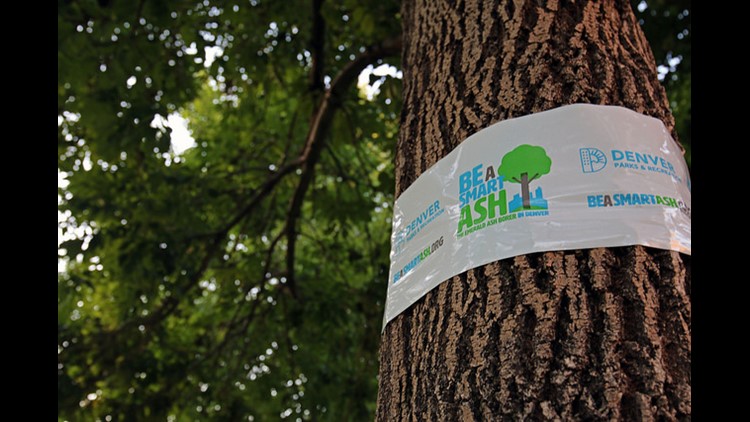ARTICLE PROVIDED BY DENVER PARKS & RECREATION
One in six trees in Denver are ash trees. And if we do nothing, it’s just a matter of time before they’ll ALL be devoured by the emerald ash borer (EAB). But who wants to be a Debbie Downer when you can Be A Smart Ash? Be A Smart Ash is a public education campaign brought to you by your friendly City Forester, an office within Denver Parks & Recreation. The Be A Smart Ash campaign aims to educate residents in the City and County of Denver on the EAB’s attempt to run amok. The goal? To encourage residents to be smart about their ashes — take action, identify ash trees and (when necessary) treat or replace them.
If you own an ash, chances are it’s of the green (Fraxinus pennsylvanica) or white (Fraxinus americana) variety. The EAB is a threat to both.
The larval stage of EAB dines in private, feeding just under the bark of trees. Infested trees die slow, painful deaths over a period of 2-4 years. Larval galleries don’t discriminate, either, as they’ve been found in trees and branches measuring as little as 1/2-inch in diameter.
If seeing is believing, take a stroll through the once-thick forests in the 25 states and parts of Canada where millions of ash trees now rot. If money talks, speak to municipalities, property owners and forest product industry operators who have lost billions of dollars to an insect that fits on a penny. At least 15 percent of Colorado’s urban and community trees are ash, and one of them might literally be in your backyard. In fact, since they aren’t native to our state, a great deal of Colorado’s ash trees are indeed on private property. And if the EAB gets its hooks into one that isn’t properly treated, that ash tree will die. Simple as that.
If that’s not enough to strike a cord, harken back to the pine beetle. Remember the damage it did to Colorado’s high country canopy? The EAB has the potential to cause comparable damage to Denver’s urban canopy.
Management & Prevention
Love your ash tree? You can keep it! EAB prevention plans depend on the value of each ash tree to a landowner. If you’d prefer the safest option with the least hassle, replacement is an option. But for those determined to hang on to their ashes, ongoing treatment options exist. For more information on both courses of action, visit BeASmartAsh.org.
Tree Replacement
Dead or alive, replacement is a viable option for all Denver ash trees given the threat posed by the EAB. Depending on the size and location of the tree, replacement may be the most intelligent solution. And why not let one smart decision beget another? When choosing to remove an ash tree, hire a licensed and insured arborist or tree service company. A list is available here: http://bit.ly/1R0xeuE
Foresight isn’t a lost art. That’s why tree replacement and tree removal should go hand-in-hand. Diversity, meanwhile, is all the rage. And for good reason. Diversified urban canopies with no more than 10 percent of any single tree are far less vulnerable to infestations. Click here for a list of approved street trees.
Treatment Options
Be a know it all: Current information on the extent of the EAB infestation as well as treatment options are available at BeASmartAsh.org. Click here for additional resources.
THIS ARTICLE INVOLVES COMMERCIAL CONTENT. THE PRODUCTS AND SERVICES FEATURED APPEAR AS PAID ADVERTISING. DIGITAL MARKETING SOLUTIONS IS A BRANCH OF THE 9NEWS SALES TEAM. FOR MORE INFORMATION, EMAIL US.



